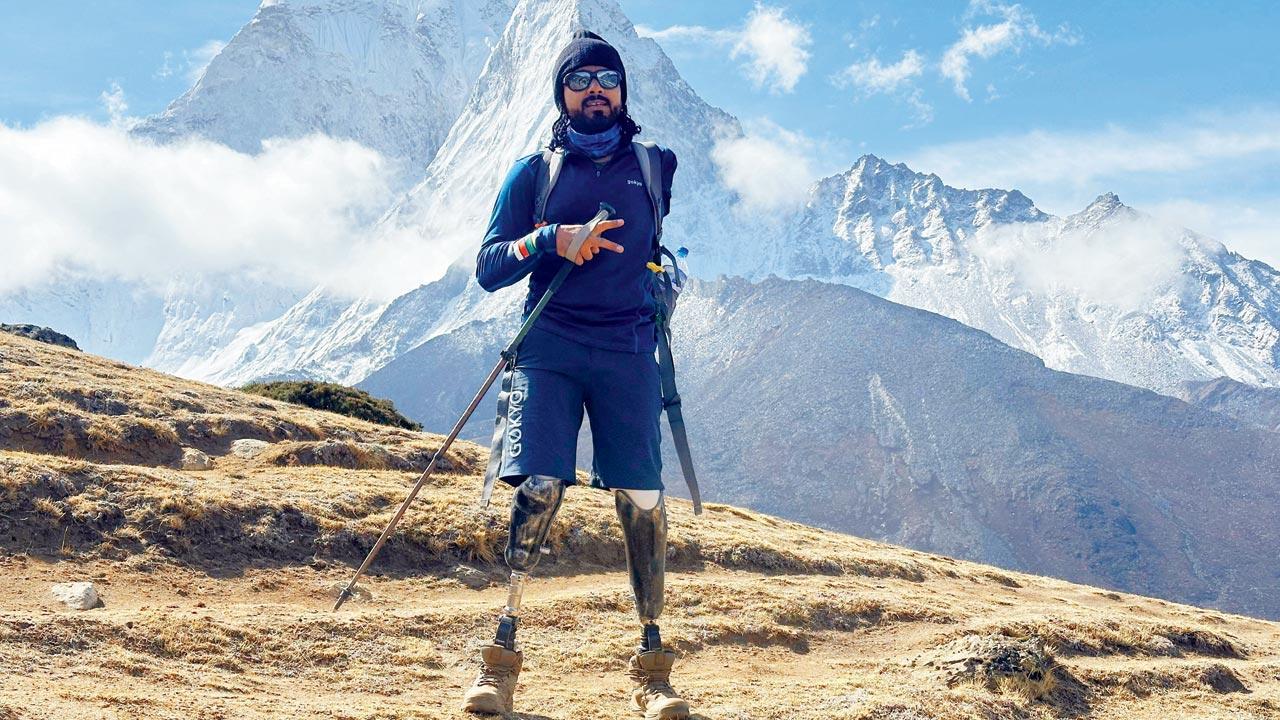Tinkesh Kaushik from Goa powered through pain to become the first triple amputee in the world to reach Everest Base Camp

Tinkesh Kaushik uses a prosthetic limb by Ossur
It's a common thought among able-bodied people, and even persons with disabilities or medical conditions, that they can’t participate in outdoor activities such as hiking or trekking in high altitudes. However, determination is a powerful force that can overcome even the most significant obstacles. “If you are determined, no matter what, you will accomplish your goal,” says Tinkesh Kaushik, a 30-year-old resident of Carmona, Salcete, in Goa.
ADVERTISEMENT
Kaushik is a living example of how sheer determination helped him achieve his goal of trekking to Everest Base Camp (EBC) (5,360 meters/17,400 feet) this May. Despite being a triple amputee for the last 21 years, Kaushik, a fitness coach and model, has not let his disability hinder his love for the outdoors and his pursuit of
ambitious goals.
At age nine, a devastating electrocution accident resulted in the loss of both his lower limbs below the knee and his left upper limb above the shoulder. But Kaushik began running marathons using the Jaipur foot, a prosthetic limb designed to provide mobility to amputees. His passion for fitness and determination to overcome his physical limitations grew, leading him to earn a certification as a fitness trainer.
After achieving feats like bungee jumping in Nepal and scuba diving in the open waters of Pondicherry as the first triple amputee, Kaushik set his sights on an even higher goal: trekking to Everest Base Camp. In May 2024, he became the first triple amputee with a 90% locomotor disability to trek to Everest Base Camp, successfully reaching EBC on May 11.
“This was by far the toughest and most dangerous feat I have attempted,” Kaushik told mid-day. The first day’s trek from Lukla to Phakding (9320 feet), a nearly four to five-hour trek, was especially challenging for him. It was downhill most of the way, causing significant pain. It took Kaushik approximately seven hours to reach Phakding.
“During the second day trek to Namche Bazar (11,280 feet), I switched my mind to be more positive and not let the pain drain out my energy. So, the trek was smooth,” he asserts.
Throughout the trek, Kaushik experienced constant pain in his right leg, which is amputated from the knee. The short stem lacks sporting muscles, making muscular pain inevitable. But he remained focused on his goal of reaching the summit. “My focus is to show the world that everything is possible, and more so to tell my fellow brethren with disabilities that everything is possible.” His fitness regime involved endurance and strength training for two hours daily at the gym, and walking approximately 10 kilometres daily with a six-kilogram backpack.
His journey, however, is not just about personal triumphs; it is also about raising awareness and support for mental health initiatives, particularly for people with disabilities (PwDs).”By successfully reaching Everest Base Camp, I want to let society know that people with disabilities are also humans with aspirations and dreams. We are warriors, but like all humans, we need help from our communities to thrive. Mental health is a significant issue among the world population today, but for PwDs, it is doubly challenging. I want them to have access to the help they need to become productive citizens,” he says.
Through his foundation-Tinkesh Ability Foundation, he intends to raise funds to support amputees, their caregivers, and their families. He aims to provide the resources necessary to help them overcome their limitations and reintegrate into mainstream society.
 Subscribe today by clicking the link and stay updated with the latest news!" Click here!
Subscribe today by clicking the link and stay updated with the latest news!" Click here!












